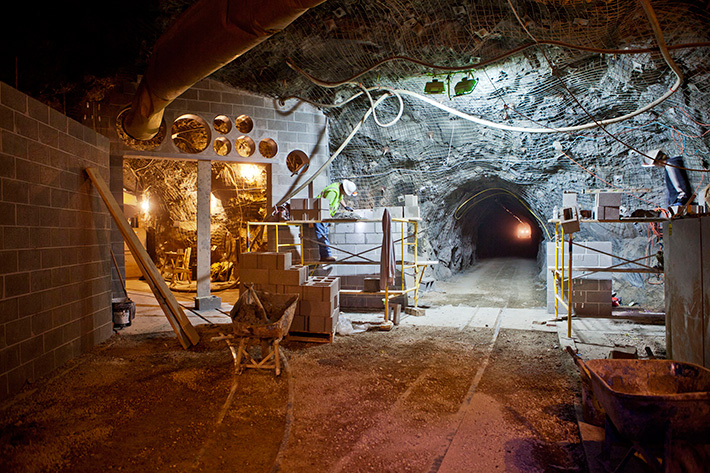
The tunnel on the left is the entrance to the cavern that will house the MAJORANA DEMONSTRATOR neutrino experiment and also provides access to the LUX experiment, which is searching for particles of dark matter. The tunnel to the right is a separate entrance to the cavern in which Ray Davis performed his famous neutrino experiment, now modified to house LUX. (Photo Matt Kapust)
The word “campus” brings to mind neo-Gothic bell towers and green lawns, not tunnels and caverns almost a mile underground. But that’s what the Davis Campus at the Sanford Underground Research Facility looks like, 4,850 feet down in the Homestake Mine in the Black Hills of South Dakota. Although SURF has weathered a series of funding ups and downs worthy of the rise and fall of the elevator cages that once took miners, and now scientists, to work in the mine, last year the U.S. Department of Energy successfully assumed sponsorship of the Sanford Lab’s scientific program from the National Science Foundation. DOE will maintain the mine as a home for existing and proposed projects to investigate dark matter, the secrets of the elusive neutrino, and other research that can only be done deep down in the dark.
The LUX Collaboration is searching for the leading candidates for unknown dark matter, weakly interacting massive particles, or WIMPs. LUX’s 350 kilograms of liquid xenon, and the low background of the Sanford Underground Research Facility, make it the most sensitive dark matter detector yet, but with the proposed LUX ZEPLIN Berkeley Lab researchers want to increase that sensitivity by orders of magnitude.
More »
DOE’s Lawrence Berkeley National Laboratory (Berkeley Lab) is the Department’s lead institution for the Sanford Lab, and Kevin Lesko of the Nuclear Science Division still wears the hard hat he put on many years ago when he first championed the Homestake Mine, then on the verge of closing down, as the ideal place to do neutrino science and other underground research. The official dedication of the Sanford Lab’s Davis Campus will be held on May 30, 2012, when scores of dignitaries from the state and federal governments, along with visiting scientists and members of the press, will trudge the subterranean burrows to hear science lectures in echoing halls of rock.
The Campus is named for Raymond Davis Jr., who beginning in the 1960s did the seminal experiment that made neutrino science one of the most exciting scientific challenges of the 21st century. Davis was searching for neutrinos from the sun with an immense barrel filled with cleaning fluid. The Homestake Mine was still going strong when he started – it was the richest gold mine the country had ever seen, perhaps best known for making the Hearst family fortune – but after many years of checking and rechecking his results and his experimental design, Ray Davis had still found only about a third the number of solar neutrinos that theorists expected.
If neutrinos are indeed the only fermions (particles of matter) that are their own antiparticles, proof will be a rare form of radioactive decay called neutrinoless double-beta decay, which could only be seen if there’s virtually no background interference. The MAJORANA DEMONSTRATOR now under construction at the Sanford Underground Research Facility in the Black Hills of South Dakota aims to prove these near-perfect conditions can be met. More »
This eventually led to the idea that neutrinos must constantly oscillate among three “flavors” – electron neutrinos (the kind made in fusion reactions that fuel the sun), plus muon neutrinos and tau neutrinos, named for their association with the electron’s heavier cousins. Davis’s cleaning-fluid experiment was sensitive to only one, the electron neutrino. Presumably the other flavors were there too, the sun’s neutrinos having mixed and changed with them while on the eight-minute trip to Earth, but Davis’s experiment couldn’t see them. After 30 years the idea of neutrino oscillation was indeed confirmed, and in 2002 Davis was awarded the Nobel Prize in Physics.
Davis’s experiment was housed in a hall now refurbished for use by the LUX search for weakly interacting massive particles (WIMPs), leading contenders for still-mysterious dark matter. Right around the corner from LUX is the MAJORANA DEMONSTRATOR, an experiment a hundred times more sensitive to radioactivity and other background signals than any like it ever built, which is setting out to prove that the search for the never-seen phenomenon of neutrinoless double-beta decay – the telltale signal that neutrinos are their own antiparticles and that the textbooks will have to be rewritten – is at least possible.